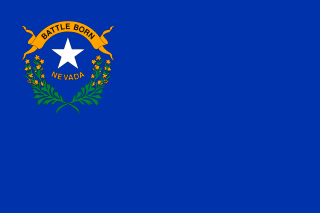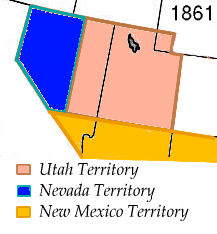Related Research Articles

Carson City, officially the Consolidated Municipality of Carson City, is an independent city and the capital of the U.S. state of Nevada, named after the mountain man Kit Carson. As of the 2020 census, the population was 58,639, making it the sixth largest city in Nevada. The majority of the city's population lives in Eagle Valley, on the eastern edge of the Carson Range, a branch of the Sierra Nevada, about 30 miles (50 km) south of Reno.

Nevada is a state in the Western region of the United States. It is bordered by Oregon to the northwest, Idaho to the northeast, California to the west, Arizona to the southeast, and Utah to the east. Nevada is the 7th-most extensive, the 32nd-most populous, and the 9th-least densely populated of the U.S. states. Nearly three-quarters of Nevada's people live in Clark County, which contains the Las Vegas–Paradise metropolitan area, including three of the state's four largest incorporated cities. Nevada's capital is Carson City while the largest city is Las Vegas.

The Territory of Nevada (N.T.) was an organized incorporated territory of the United States that existed from March 2, 1861, until October 31, 1864, when it was admitted to the Union as the State of Nevada.

The Territory of Arizona was a territory of the United States that existed from February 24, 1863, until February 14, 1912, when the remaining extent of the territory was admitted to the Union as the state of Arizona. It was created from the western half of the New Mexico Territory during the American Civil War.

The Territory of Jefferson was an extralegal and unrecognized United States territory that existed from October 24, 1859 until the creation of the Colorado Territory on February 28, 1861. The Jefferson Territory, named for Founding Father and United States president Thomas Jefferson, included land officially part of the Kansas Territory, the Nebraska Territory, the New Mexico Territory, the Utah Territory, and the Washington Territory, but the area was remote from the governments of those five territories.

Bullfrog County was an uninhabited county in the U.S. state of Nevada created by the Nevada Legislature in 1987. It comprised a 144-square-mile (370 km2) area around Yucca Mountain enclosed by Nye County, from which it was created. Its county seat was located in the state capital of Carson City 270 miles (430 km) away, and its officers were appointed by the governor rather than elected.

Nevada's 2nd congressional district is a congressional district that includes the northern third of the state. It includes most of Lyon County, all of Churchill, Douglas, Elko, Eureka, Humboldt, Lander, Pershing, Storey, and Washoe counties, as well as the state capital, Carson City. The largest city in the district is Reno, the state's third largest city. Although the district appears rural, its politics are dominated by Reno and Carson City. As of 2017, over 460,000 people reside in Washoe County alone, totaling about two-thirds of the district's population.

The Nevada Legislature is a bicameral body, consisting of the lower house, the Assembly, with 42 members, and the upper house, the Senate, with 21. With a total of 63 seats, the Legislature is the third-smallest bicameral state legislature in the United States, after Alaska's and Delaware's (62). The Nevada State Legislature as of 2019 is the first majority female State Legislature in the history of the United States. As of 2021, the Democratic Party controls both houses of the Nevada State Legislature.
The Nevada State Democratic Party (NSDP) is the affiliate of the Democratic Party in the U.S. state of Nevada. It has been chaired by Judith Whitmer since March 2021.

The History of Nevada as a state began when it became the 36th state on October 31, 1864, after telegraphing the Constitution of Nevada to the Congress days before the November 8 presidential election. Statehood was rushed to help ensure three electoral votes for Abraham Lincoln's reelection and add to the Republican congressional majorities.

AbrahamVan Santvoord Curry is considered the founding father of Carson City, Nevada. A native of the state of New York, he traveled to the West Coast during the California Gold Rush and settled in Nevada's Eagle Valley, where Carson City was established.

Eagle Valley is the area encompassing Carson City, Nevada. The valley was first settled during the California Gold Rush of 1849. The discovery of Nevada's Comstock Lode in 1859 established the economic importance of the area, which would become the site of the Nevada State Capitol.
The Sierra Seminary was a private, co-educational school in Carson City, Nevada, US. With the support of the Nevada Territory Legislature, Governor James W. Nye and U.S. Senator William Morris Stewart, it was established in 1860, and founded the following year, by Hannah Keziah Clapp, the first instructor and librarian at the University of Nevada, Reno. Clapp was assisted by Mrs. Cutler and later by Miss Elizabeth C. Babcock. Many of Nevada's prominent citizens of the day were educated at this school. By 1864, there were about 40 students, and in 1865, a new building was erected. Mark Twain visited Sierra Seminary twice, subsequently incorporating some of what he observed into his 1876 novel, The Adventures of Tom Sawyer. It existed until approximately 1886.

The Nevada general election, 2014 was held on Tuesday, November 4, 2014, throughout Nevada.
Octavius Decatur "O. D." Gass was an American prospector, businessman, and politician. A four term member of the Arizona Territorial Legislature, he was active in the early history of Las Vegas, Nevada and the creation of Pah-Ute County, Arizona Territory.
Francis "Frank" Marion Proctor was an American lawyer, state senator, and co-founder of Carson City, Nevada.
A. H. Greenhalgh was an American politician affiliated with the Democratic Party. On November 8, 1870, he was elected representative of Nye County in the Nevada Assembly with John Bowman. Greenhalgh's term started the following day and he served in one regular session. Records from the session stated that he resided in Twin River. Greenhalgh's mandate ended after the next elections, that were held in November 1872. At those elections, John Bowman and H. G. Prague were elected the Nye County representatives in the Assembly.
References
- 1 2 Secretary of State of Nevada; Research Division of the Legislative Counsel Bureau (2016). Political History of Nevada (PDF) (12th ed.). Carson City: Barbara Cegavske. p. 300.
- 1 2 3 Bowers, Michael W. (2013). The Sagebrush State: Nevada's History, Government, and Politics (4th ed.). Reno: University of Nevada Press. pp. 15 and 16. ISBN 978-0-87417-923-1.
- 1 2 3 Green, Michael S. (2015). Nevada: A History of the Silver State. Reno: University of Nevada Press. p. 86. ISBN 978-0-87417-973-6.